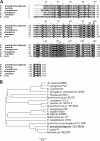Characterization of the Pseudomonas pseudoalcaligenes CECT5344 Cyanase, an enzyme that is not essential for cyanide assimilation
- PMID: 18708510
- PMCID: PMC2570302
- DOI: 10.1128/AEM.00916-08
Characterization of the Pseudomonas pseudoalcaligenes CECT5344 Cyanase, an enzyme that is not essential for cyanide assimilation
Abstract
Cyanase catalyzes the decomposition of cyanate into CO(2) and ammonium, with carbamate as an unstable intermediate. The cyanase of Pseudomonas pseudoalcaligenes CECT5344 was negatively regulated by ammonium and positively regulated by cyanate, cyanide, and some cyanometallic complexes. Cyanase activity was not detected in cell extracts from cells grown with ammonium, even in the presence of cyanate. Nevertheless, a low level of cyanase activity was detected in nitrogen-starved cells. The cyn gene cluster of P. pseudoalcaligenes CECT5344 was cloned and analyzed. The cynA, cynB, and cynD genes encode an ABC-type transporter, the cynS gene codes for the cyanase, and the cynF gene encodes a novel sigma(54)-dependent transcriptional regulator which is not present in other bacterial cyn gene clusters. The CynS protein was expressed in Escherichia coli and purified by following a simple and rapid protocol. The P. pseudoalcaligenes cyanase showed an optimal pH of 8.5 degrees C and a temperature of 65 degrees C. An insertion mutation was generated in the cynS gene. The resulting mutant was unable to use cyanate as the sole nitrogen source but showed the same resistance to cyanate as the wild-type strain. These results, in conjunction with the induction pattern of the enzymatic activity, suggest that the enzyme has an assimilatory function. Although the induction of cyanase activity in cyanide-degrading cells suggests that some cyanate may be generated from cyanide, the cynS mutant was not affected in its ability to degrade cyanide, which unambiguously indicates that cyanate is not a central metabolite in cyanide assimilation.
Figures






Similar articles
-
Cyanate Assimilation by the Alkaliphilic Cyanide-Degrading Bacterium Pseudomonas pseudoalcaligenes CECT5344: Mutational Analysis of the cyn Gene Cluster.Int J Mol Sci. 2019 Jun 20;20(12):3008. doi: 10.3390/ijms20123008. Int J Mol Sci. 2019. PMID: 31226739 Free PMC article.
-
DNA microarray analysis of the cyanotroph Pseudomonas pseudoalcaligenes CECT5344 in response to nitrogen starvation, cyanide and a jewelry wastewater.J Biotechnol. 2015 Nov 20;214:171-81. doi: 10.1016/j.jbiotec.2015.09.032. Epub 2015 Sep 30. J Biotechnol. 2015. PMID: 26432339
-
The cyanase operon and cyanate metabolism.FEMS Microbiol Rev. 1990 Dec;7(3-4):247-52. doi: 10.1111/j.1574-6968.1990.tb04920.x. FEMS Microbiol Rev. 1990. PMID: 2094285 Review.
-
Bacterial degradation of cyanide and its metal complexes under alkaline conditions.Appl Environ Microbiol. 2005 Feb;71(2):940-7. doi: 10.1128/AEM.71.2.940-947.2005. Appl Environ Microbiol. 2005. PMID: 15691951 Free PMC article.
-
Bacterial cyanide degradation is under review: Pseudomonas pseudoalcaligenes CECT5344, a case of an alkaliphilic cyanotroph.Biochem Soc Trans. 2011 Jan;39(1):269-74. doi: 10.1042/BST0390269. Biochem Soc Trans. 2011. PMID: 21265786 Review.
Cited by
-
Alternative Pathway for 3-Cyanoalanine Assimilation in Pseudomonas pseudoalcaligenes CECT5344 under Noncyanotrophic Conditions.Microbiol Spectr. 2021 Dec 22;9(3):e0077721. doi: 10.1128/Spectrum.00777-21. Epub 2021 Nov 3. Microbiol Spectr. 2021. PMID: 34730416 Free PMC article.
-
Ascaris lumbricoides β carbonic anhydrase: a potential target enzyme for treatment of ascariasis.Parasit Vectors. 2015 Sep 18;8:479. doi: 10.1186/s13071-015-1098-5. Parasit Vectors. 2015. PMID: 26385556 Free PMC article.
-
Entrapment of Cyanase from Thermomyces lanuginosus Using Biomimetic Silica and Its Application for Cyanate Bioremediation.Polymers (Basel). 2024 Sep 13;16(18):2594. doi: 10.3390/polym16182594. Polymers (Basel). 2024. PMID: 39339058 Free PMC article.
-
Involvement of β-Carbonic Anhydrase Genes in Bacterial Genomic Islands and Their Horizontal Transfer to Protists.Appl Environ Microbiol. 2018 Jul 17;84(15):e00771-18. doi: 10.1128/AEM.00771-18. Print 2018 Aug 1. Appl Environ Microbiol. 2018. PMID: 29802189 Free PMC article.
-
Proteomics Analysis of the Effects of Cyanate on Chromobacterium violaceum Metabolism.Genes (Basel). 2011 Oct 19;2(4):736-47. doi: 10.3390/genes2040736. Genes (Basel). 2011. PMID: 24710289 Free PMC article.
References
-
- Aichi, M., I Nishida, and T. Omata. 1998. Molecular cloning and characterization of a cDNA encoding cyanase from Arabidopsis thaliana. Plant Cell. Physiol. Suppl. 39:S135.
-
- Altschul, S. F., W. Gish, W. Miller, E. W. Myenrs, and D. J. Lipman. 1990. Basic local alignment tool. J. Mol. Biol. 215:403-410. - PubMed
-
- Anderson, P. M. 1980. Purification and properties of the inducible enzyme cyanase. Biochemistry 19:2882-2888. - PubMed
-
- Becker, A., M. Schmidt, W. Jäger, and A. Pühler. 1995. New gentamicin-resistance and lacZ promoter-probe cassettes suitable for insertion mutagenesis and generation of transcriptional fusions. Gene 162:37-39. - PubMed
Publication types
MeSH terms
Substances
Associated data
- Actions
LinkOut - more resources
Full Text Sources

